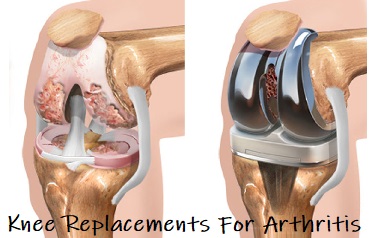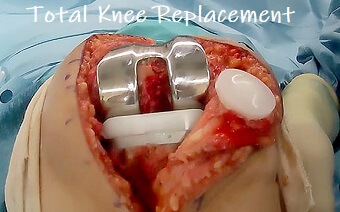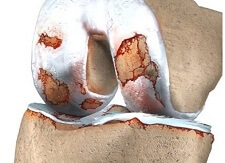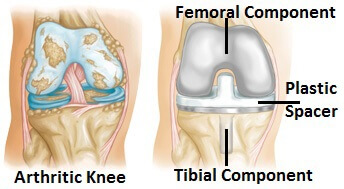- Home
- Knee Surgery
- Knee Replacements
- Surgery
Total Knee Replacement Surgery
Written By: Chloe Wilson, BSc(Hons) Physiotherapy
Reviewed by: KPE Medical Review Board

Total knee replacement surgery is a common operation to treat advanced arthritis.
An orthopedic surgeon removes the damaged and worn part of the joint and replaces them with a new artificial knee made of metal and plastic.
The aim of a knee replacement is to significantly reduce pain and improve function.
Most people find total knee replacements really beneficial, reporting a marked decrease in pain and improvement in their day to day life quite soon after surgery. total knee replacement surgery, total knee replacement surgery
Here we will look at how you prepare yourself for knee replacement surgery, what the operation involves, and what happens afterwards.
This is intended as a guide as to what happens for the average person undergoing total knee replacement surgery, but remember that everyone is different and recovery will therefore vary slightly from person to person. Always follow the advice of your surgeon or physical therapist.
Preparing For Surgery
Before having total knee replacement surgery, you will have a pre-op appointment a few days/weeks before your operation where the surgeon will review your x-rays and talk you through what is going to happen. This is a good opportunity to ask any questions you may have.
This video from the American Academy of Orthopedic Surgeons has loads of top tips on preparing for joint replacement surgery.
At the same appointment you should also see a physical therapist who will talk through knee replacement rehab and recovery e.g. exercises for you to do after the operation.
It is well worth doing these exercises for a few weeks before your total knee replacement surgery as the stronger and more flexible your knee is before surgery, the quicker you will recover afterwards. Visit the knee replacement exercise section for suitable exercises.
What Happens During Total Knee Replacement Surgery?
On the day of your total knee replacement surgery you be admitted to hospital. You will go through various pre-op checks and when it's your turn, you'll be taken down to theatre.

Total knee replacement surgery is usually carried out with either:
- General Anaesthetic: you are put to sleep for the duration of the operation
- Spinal Anaesthetic: (epidural) numbs the body below the waist and you are also given medicine to make you sleepy
A vertical incision (cut) is made on the front of the knee, usually about 8-10 inches long. The kneecap is moved to the side to expose the joint. The surgeon removes the damaged bone and cartilage.
In most cases the anterior cruciate ligament (ACL) is removed and often the posterior cruciate ligament (PCL) is too. The collateral ligaments are preserved.
The bones are shaped to fit the new knee implants, which are made up of four components:
- Femoral Component: this curves around the bottom end of the femur and has a groove in the center for the kneecap that mimics the trochlear groove. This allows the kneecap to glide smoothly and freely up and down as the knee moves.
- Tibial Component: this flat platform sits on top of the tibia and usually has a metal stem that inserts down the shin bone to hold the component firmly in place
- Plastic Spacer: the metal components are separated by a plastic spacer to allow smooth movement and to prevent wear and tear of the prosthesis
- Patellar Component: if there is arthritis at the back of the patella then the disease bone is removed and a dome-shaped plastic component resembling a large button is fitted. However if the patella is in good condition, it is preserved as it is
The appropriate components are attached to the bones and held in place with
cement. The wound is then sewn up with stitches. A dressing will be
placed over the wound and the knee will then be bandaged to help reduce
swelling.
Total knee replacement surgery takes about 2 hours.
Recently a new design of prosthesis which fits around the cruciate ligaments has been developed but there are few studies comparing its performance to a regular knee replacement at present.
If you would like to actually see what happens, visit the knee replacement video section.
What Happens After Surgery?
After your total knee replacement surgery, you will return to your ward and the nurses will ensure you are getting adequate pain relief.
Check Out Our Book
All the info you need about knee arthritis, top tips, exercises & loads more.
Rated 4.4/5
Find Out More
Either later that day or the next morning, a physiotherapist will come to see you and help you get out of bed. You will most likely be able to fully weight bear on your new knee, i.e. put as much weight through your leg as you feel comfortable doing, within 24 hours but you may need to use a frame, crutches or sticks for the first few days.
You will start your exercises straight away and will progress through the rehab program as instructed by a physical therapist. You can find a whole range of exercises that can help in the knee replacement exercise section.
People are normally discharged from hospital after 3-5 days following total knee replacement surgery (occasionally longer) depending on how they are doing. Before you can go home, you should be able to:
- Get in and out of bed by yourself
- Walk safely with or without crutches/sticks/frame
- Climb steps and stairs (unless you don’t have any at home)
- Fully straighten your knee
- Bend your knee well, preferably at least 90° (can take longer to achieve this if the movement was severely restricted prior to surgery)
About a month after total knee replacement surgery you should be noticing a lot of improvement in your knee. However, it is normal for it to be swollen and uncomfortable the first few days following surgery but the pain usually settles down within a few weeks. You can help reduce the swelling by using Ice and Tubigrip (a special compression bandage).
It is really important to be doing exercises to build up the strength and flexibility around your knee to gain the full benefit of total knee replacement surgery (see the knee replacement exercise section). You will be able to stop using any walking aids such as crutches or sticks as soon as you feel able – usually in a few days, and certainly by six weeks.
Find Out More
If you want to know more about knee replacement surgery, visit the sections below:
- Knee Replacement Overview: Including how to tell if you would benefit from surgery
- Rehab: Including what you can do to get the best results
- Recovery:
Including a guide to when you can return to activities
- Common Problems: Common problems associated with knee replacement surgery
- Common Questions: Frequently asked questions about knee replacements
- Knee Replacement Video: See what actually happens during surgery
- Knee Replacement Book: Our popular guide to knee replacements and knee arthritis - available in paperback or on Kindle
- Partial Knee Replacements: Less invasive surgery where only one side of the knee is replaced
Page Last Updated: 06/29/22
Next Review Due: 06/29/24
Related Articles
Knee Swelling
March 12, 2023

Best Diet For Arthritis
January 11, 2023
Improve Flexibility
September 30, 2025









